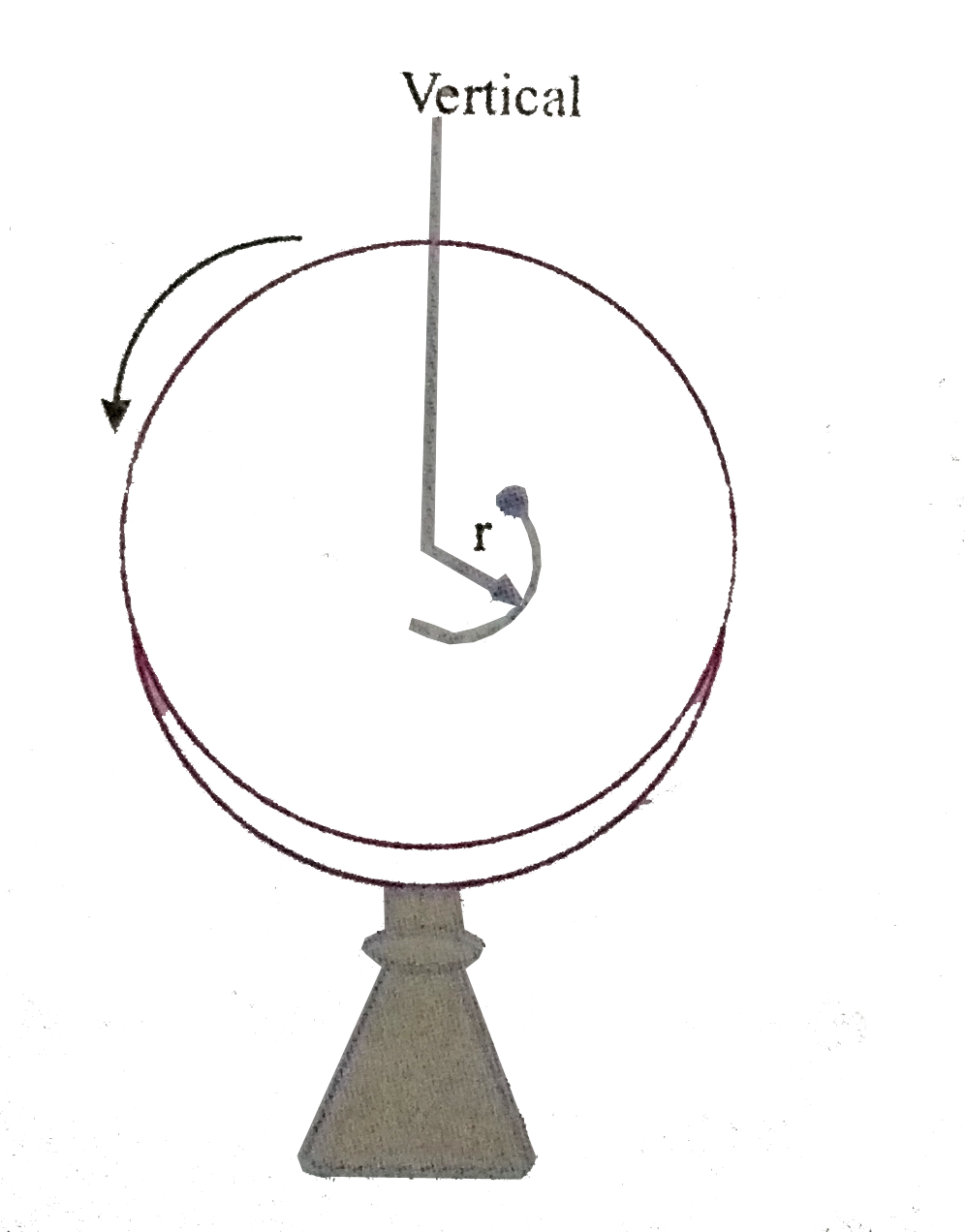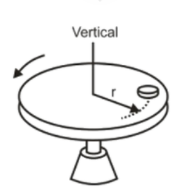A coin is kept at distance of 10 cm from the centre of a circular turn table. If μ=0.8 the frequency of rotation at which the coin just begins to slip is
62.8 rpm
84.54 rpm
54.6 rpm
32.4 rpm
The correct Answer is:B
To solve the problem of finding the frequency of rotation at which the coin just begins to slip, we can follow these steps:
Step 1: Identify the given values
- Distance from the center of the circular turntable (r) = 10 cm = 0.1 m
- Coefficient of friction (μ) = 0.8
- Acceleration due to gravity (g) = 9.8 m/s²
Step 2: Write the equation for the forces
The frictional force provides the necessary centripetal force to keep the coin moving in a circle. The equation is:
μmg=mω2r
Here, m is the mass of the coin, which will cancel out from both sides.
Step 3: Simplify the equation
Cancel m from both sides:
μg=ω2r
Step 4: Solve for angular velocity (ω)
Rearranging the equation gives us:
ω2=μgr
Taking the square root:
ω=√μgr
Step 5: Substitute the known values
Substituting the values of μ, g, and r into the equation:
ω=√0.8×9.80.1
Step 6: Calculate ω
Calculating the value:
ω=√7.840.1
ω=√78.4
ω≈8.85 rad/s
Step 7: Convert angular velocity to frequency (f)
We know that:
ω=2πf
Rearranging gives:
f=ω2π
Step 8: Substitute the value of ω
Substituting the value of ω:
f=8.852π
f≈8.856.2832
f≈1.41 rps
Step 9: Convert frequency from rps to rpm
To convert from revolutions per second (rps) to revolutions per minute (rpm):
rpm=f×60
rpm=1.41×60
rpm≈84.54
Final Answer
The frequency of rotation at which the coin just begins to slip is approximately 84.54 rpm.
---
- Distance from the center of the circular turntable (r) = 10 cm = 0.1 m
- Coefficient of friction (μ) = 0.8
- Acceleration due to gravity (g) = 9.8 m/s²
The frictional force provides the necessary centripetal force to keep the coin moving in a circle. The equation is:
μmg=mω2r
Here, m is the mass of the coin, which will cancel out from both sides.
Cancel m from both sides:
μg=ω2r
Rearranging the equation gives us:
ω2=μgr
Taking the square root:
ω=√μgr
Substituting the values of μ, g, and r into the equation:
ω=√0.8×9.80.1
Calculating the value:
ω=√7.840.1
ω=√78.4
ω≈8.85 rad/s
We know that:
ω=2πf
Rearranging gives:
f=ω2π
Substituting the value of ω:
f=8.852π
f≈8.856.2832
f≈1.41 rps
To convert from revolutions per second (rps) to revolutions per minute (rpm):
rpm=f×60
rpm=1.41×60
rpm≈84.54
The frequency of rotation at which the coin just begins to slip is approximately 84.54 rpm.
Similar Questions
A small coin of mass 80g is placed on the horizontal surface of a rotating disc. The disc starts from rest and is given a constant angular acceleration α=2rad/s2. The coefficient of static friction between the coin and the disc is μs=3/4 and cofficient of kinetic friction is μk=0.5. The coin is placed at a distance r=1m from the centre of the disc. The magnitude of the resultant force on the coin exerted by the disc just before it starts slipping on the disc is

View SolutionA small coin of mass 40 g is placed on the horizontal surface of a rotating disc. The disc starts from rest and is given a constant angular acceleration α=2 rad s−2. The coefficient of static friction between the coin and the disc is μs=3/4 and the coefficient of kinetic friction is μk=0.5. The coin is placed at a distance r=1m from the centre of the disc. The magnitude of the resultant force on the coin exerted by the disc just before it starts slipping on the disc is?

View SolutionA small coin of mass 80g is placed on the horizontal surface of a rotating disc. The disc starts from rest and is given a constant angular acceleration α=2rad/s2. The coefficient of static friction between the coin and the disc is μs=3/4 and cofficient of kinetic friction is μk=0.5. The coin is placed at a distance r=1m from the centre of the disc. The magnitude of the resultant force on the coin exerted by the disc just before it starts slipping on the disc is

View SolutionFind the length of a chord which is at a distance of 5 cm from the centre of a circle of radius 10 cm.
View SolutionA disc rotates about its aixs of symmetry in a horizontal plane at a steady rate of 3.5 revolutions per second A coin placed at a distance fo 1.25 cm form the axis of ratation remains at rest on the disc The coefficient of friction between the coin and the disc is : (g=10/s2)
View SolutionAs mosquito is sitting on an L.P. record disc rotating on a trun tabel at 3313 revolutions per minute. The distance of the mosquito from the centre of the turn table is 10 cm. Show that the friction coefficient between the record and the mosquito is greater than π281. Take g=10ms2
View SolutionA coin placed on a rotating turntable just slips if it is placed at a distance of 4 cm from the centre. If the angular velocity of the turntable is doubled, it will just slip at a distance of
View SolutionA small coin of mass 5 g is placed at a distance 5 cm from centre on a flat horizontal turn table. The turn table is observed to make 3 revolutions in √10s. The frictional force on the coin is (n×10−3)N. Find value of n.
View SolutionA small coin is placed at a distance r from the centre of a gramophone record.The rotational speed of the record is gradually increased. If the coefficient of friction between the coin and the record is μ, the minimum angular frequency of the record for which the coin will fly off is given by :
View SolutionA long playing record revolves with a speed of 33(14) rev/min. and has a radius of 15 cm. Two coins are placed at 4 cm and 14 cm away from the centre of the record. If the coefficients of friction between the coin and the record is 0.15, which of the two coins will revolve with record ?
View Solution
